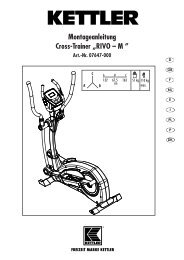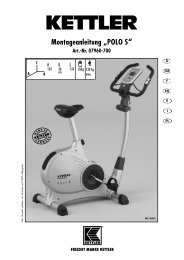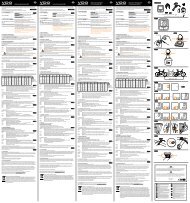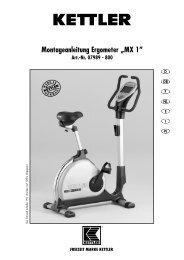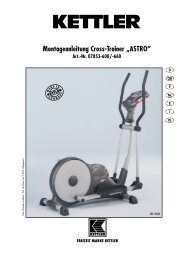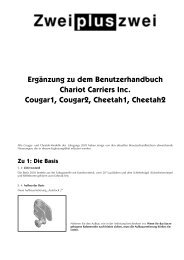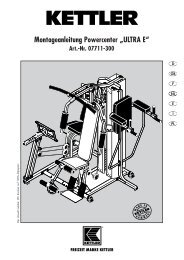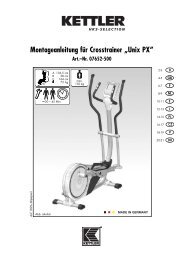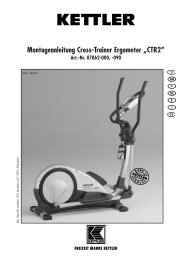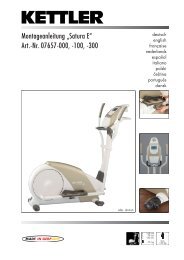1999 SID Rear Shock Owner's Manual - Fahrrad Kaiser Gmbh
1999 SID Rear Shock Owner's Manual - Fahrrad Kaiser Gmbh
1999 SID Rear Shock Owner's Manual - Fahrrad Kaiser Gmbh
You also want an ePaper? Increase the reach of your titles
YUMPU automatically turns print PDFs into web optimized ePapers that Google loves.
Rebound Damping Adjustment (some models)<br />
The <strong>SID</strong> shock includes a red rebound damping adjustment knob. The rebound controls the extension or<br />
return of the shock. The shock’s rebound is quickest when the adjustment knob is in the full counterclockwise<br />
position. Rebound is slowest when the adjustment knob is in the full clockwise position.<br />
DOWNHILL TUNING:<br />
To optimize the downhill rebound, do a washboard test. Use a typical ride that has washboard or braking<br />
bumps. Go through the washboard or braking bumps a couple times to feel for consistency through the bumps.<br />
The rebound is just right when the wheel follows each bump and feels smooth throughout. The first bump<br />
should be as smooth as the last bump.<br />
SYMPTOMS OF TOO MUCH REBOUND:<br />
Slow shock return, where the shock feels good through the first few bumps and gets harder as you continue, means<br />
there is too much rebound. In addition, while breaking, the rear wheel will tend to skip over the bumps. To adjust<br />
it for more consistency and better breaking, turn the rebound knob a half turn counterclockwise and test it again.<br />
SYMPTOMS OF TOO LITTLE REBOUND:<br />
Too little rebound is when the shock returns too fast and the bike seems to want to buck you off or the rear<br />
wheel skips out. Turn the rebound knob a half turn clockwise to slow the rebound down for more consistency<br />
and better braking through the bumps.<br />
ADVANCED HINTS<br />
For bikes that need to be adjusted for rebound when climbing, turn in the rebound until the bobbing<br />
disappears.<br />
Maintenance<br />
RockShox <strong>SID</strong> shock is designed for high performance. To insure this, we recommend keeping the shock body<br />
as clean as possible. It is also recommended that the shock be overhauled by a qualified mechanic with proper<br />
tools once a year or more often if you ride in extreme conditions. A service manual explaining overhaul<br />
procedures is available through your local dealer or from RockShox direct at 1.800.677.7177.<br />
Over time, the oil inside the shock will degrade and the shock will start to lose damping. The shock will<br />
compress and rebound too fast when damping loss is significant. This indicates the shock needs to be serviced.<br />
This service should only be performed by a RockShox dealer or call RockShox direct.<br />
Lubrication of Air Spring - Once per year. This service requires the current RockShox Deluxe Service <strong>Manual</strong>.<br />
Seal Inspection and Replacement - This service requires the current RockShox Deluxe Service <strong>Manual</strong>.<br />
Air Spring Pressure - Check every ride, slight air loss might occur over a few days.<br />
GENERAL UPKEEP:<br />
Washing Your Deluxe <strong>Shock</strong>: Clean your shock with mild soap and a toothbrush. Keep the body and<br />
body eye bushings cleaned and greased.<br />
IMPORTANT: NEVER USE A HIGH-POWERED WASHER FOR CLEANING THE SHOCK<br />
Oil Change Intervals: We recommend that the oil be changed in your shock annually. However, if you<br />
ride in extreme conditions the oil should be changed more often than once a year.<br />
Oil Leaks: One hundred percent serviceable. Contact a local RockShox dealer or RockShox direct to have<br />
your rear shock serviced.<br />
Glossary of Terms<br />
Bottoming Out – the condition when all suspension travel has been used up.<br />
Compression Stroke – the "upward" motion of a fork which is moving in response to a bump impact.<br />
Damping Force – the force required to move a shock absorber/damper (general oil) at any given speed.<br />
Forged – a metal forming process which optimizes material structure using very large forces acting on a<br />
die mold in which material to formed is placed.<br />
Geometry – Descriptive term for the lengths and angles used in a bicycle design.<br />
Head angle – Angle the steering axis leans back from vertical. Increased head angle makes steering faster<br />
and decreased head angle makes steering slower.<br />
One piece – unitized lower leg assembly with both fork legs and fork brace cast as one piece.<br />
Preload – The amount either in pounds or inches, a spring is compressed when fitted to an extended<br />
shock absorber.<br />
Rebound – The extension or return direction of the shocks or suspension.<br />
Sag – compression of the suspension caused by the rider’s weight.<br />
Spring rate – The amount of force required to deflect a spring a given distance.<br />
Tapered – varying wall thickness of a tube. A design to optimize placement of material, allowing most<br />
efficient design considering the loads.<br />
Topping out – the position of the fork at the "top" of the travel, or when the fork is fully extended. The<br />
action of complete extension of the fork.<br />
• Ride on open trails only<br />
• Leave no trace<br />
• Control your bicycle<br />
• Always yield trail<br />
• Never spook animals<br />
IMBA Rules of the Trail<br />
PAGE 8 PN 950-001973-00, REV. A PN 950-001973-00, REV. A PAGE 9




